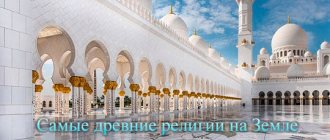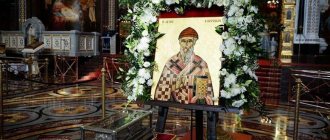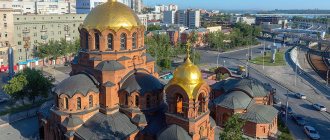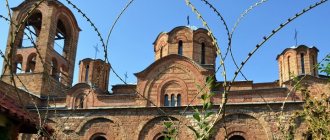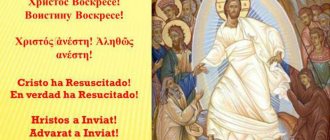Ethiopia is the only traditional African country
Ethiopia or the Federal Democratic Republic of Ethiopia is a state in East Africa. Since Eritrea seceded from its membership on May 24, 1993, it has no access to the sea. Previously known as Abyssinia.
Ethiopia is the only traditionally Christian African country. One of its main religions is Eastern Christianity (Ethiopian Church). This fact makes it quite easy to answer the question: what is the faith of the Ethiopians?
Church of St. George in Lalibela. Ethiopia is the only traditionally Christian country in Africa. Photo: upload.wikimedia.org
The Ethiopian Church is an Orthodox Church, but it adheres to Miaphysitism. Lutheranism has been actively spreading among the Oromo people in recent decades, as a result of which the Ethiopian Mekane Yesus Church is the fastest growing Lutheran denomination in the world.
Other Protestant groups include Presbyterians, Baptists, Adventists, and the Pentecostal Christian Church, the Worldwide Fellowship of the Assemblies of God.
According to the 1994 census data, the country had the following number of followers of a particular religion:
- Eastern Christianity (Ethiopian Church)—50.6%;
- Protestant Christians - 10.2%;
- Muslims - 32.8%;
- aboriginal cults - 4.6%;
- others - 1.8%.
50%
so many Ethiopians are parishioners of the Ethiopian Church
The Ethiopian Constitution provides for freedom of religion for citizens. In general, the Ethiopian authorities adhere to this principle. In addition, the country's Constitution also establishes the principle of separation of church and state and prohibits the existence of a state religion.
In the 1990s, there was a radicalization of part of the Islamic population, which partially went into open conflict with the central government, so the government currently controls the process of construction of religious buildings by the Christian and Muslim communities of the country.
Ethiopia flag. Ethiopia has constitutionally enshrined the principle of freedom of religion. Photo: upload.wikimedia.org
By law, all religious associations in the country must be registered (registration is renewed every 3 years. In interreligious relations, the central government takes an emphatically neutral position as a mediator.
In addition, the central government prohibits religious education in public and private schools. Both Christian and Muslim holidays are recognized. In Ethiopia, it is prohibited to form parties on religious grounds.
Content
- 1 Christianity in Ethiopia
- 2 History 2.1 The Ethiopian Church 2.1.1 The emergence of the Ethiopian Church
- 2.1.2 Ethiopian Church in Modern Times
- 2.1.3 Features of the Ethiopian Church 2.1.3.1 Scripture and theology
- 2.1.3.2 Temples
- 2.1.3.3 Iconography
- 2.1.3.4 Worship
- 2.1.3.5 Posts
In Ethiopia, up to 10% of the population adheres to traditional beliefs
In Ethiopia, the number of followers of traditional beliefs ranges from 5 to 10% of the population of this country. They live mainly in the south and southwest of the country. In their beliefs, a large place is given to the forces of nature.
from 5 to 10%
so many Ethiopians adhere to traditional beliefs
The main place is occupied by the cult of “Atetier” - the cult of childbirth and fertility. At the same time, local Christians and Muslims also revere the forces of nature. Priests of traditional religions, as a rule, act as a special closed caste - bearers of sacred knowledge.
Representatives of the Ethiopian Oromo people. In Ethiopia, many tribes and nationalities practice traditional religion. animist religion
In remote areas in the south of the country, the Oromo (the largest people in Ethiopia) continue to worship the good supreme god Uak. Evil is personified by Borentiti (or saitan). The Oromo spiritualize nature by worshiping various natural objects and phenomena.
The cult of nature is associated in their ideas with the symbolism of numbers: every object and phenomenon has its own number. In certain Oromo (Borana) groups in the south of the country, the institution of gender and age groups - “Gada” - has been preserved. For 8 years, a certain group must perform certain duties in the life of the community (then rotation occurs).
Women of the Ethiopian Mursi tribe kill their husbands with drugs.
In some places in Ethiopia, pagan cults with shocking customs have been preserved. So, for example, among some Nilotic tribes in the river valley. Omo, in the extreme south of the country there is a cult of the god of death, Yamda.
This is especially true for the Mursi tribe. The women of this tribe are the priestesses of Yamda. They kill their husbands in his honor, using narcotic herbs for this.
Animism (the belief that everything in nature is animated)
No more than 12% of the country’s total population is committed to this specific religion; in some areas it is closely intertwined with Orthodoxy: the clergy in Christian Ethiopia has not only the usual priests, but also a separate caste - the Debters. They are believed to be intermediaries between ordinary people and the world of natural spirits, which many Ethiopians also believe in, despite their main religion. The population of Ethiopia respects holy places, therefore, on the territory of temples, monasteries and lands adjacent to them, violence of any kind is prohibited, even the smallest animal or, on the contrary, a wild animal will never be touched, respectfully bypassing it.
Debters perform ritual services to appease spirits when nature is angry, perform ritual dances that take place even at ordinary Christian services, and also act as healers and healers for those who ask them for help.
Most Ethiopian Christians belong to the Ethiopian Orthodox Church
Ethiopia is the third country after Armenia and the Kingdom of Osroene to officially adopt Christianity.
According to the 1994 census, 61.6% of the country's population are Christians, including 50.6% adherents of the pre-Chalcedonian Ethiopian Church, 10.1% Protestants and 0.9% Catholics. The Ethiopian (Abyssinian) Orthodox Church is one of the Ancient Eastern (pre-Chalcedonian) churches.
61,5%
how many Ethiopians, according to the 1994 census, are Christians
Until 1959, it had autonomy and was canonically dependent on the Coptic Church, after which it received autocephaly. Like other Ancient Eastern churches, it recognizes three Ecumenical Councils and professes Miaphysite Christology. It has its own Ethiopian rite, as well as a special hierarchical structure of the clergy that has no analogues in other church traditions.
Saint Frumentius of Aksum. Frumentius is the enlightener of Ethiopia, the first bishop of Aksum. Photo: upload.wikimedia.org
According to Eusebius Pamphilus and the New Testament, Christianity came to Ethiopia in the first century from the Apostle Philip, who converted a eunuch, from the envoys of the Queen of Candace. Tradition also says that the first Christian educator of the Ethiopians was Frumentius, a Roman citizen from Tyre, who was shipwrecked on the African coast of the Red Sea.
He converted Emperor Aksum of Ethiopia to Christianity. Frumentius was subsequently ordained bishop by Athanasius of Alexandria, returned to Ethiopia and, becoming the first bishop of Aksum, continued the evangelization of the country.
The Ethiopian Church is led by Abuna, the patriarch.
Administratively, the Ethiopian Church from its very inception was one of the dioceses of the Coptic Patriarch of Alexandria, who appointed the Egyptian bishop to abun. Abuna was the only bishop of Ethiopia.
Christian Ethiopians adhere to some Old Testament commandments that are considered irrelevant by most Christians, such as observing food laws. Circumcision of male infants is also practiced (on the eighth day, according to the commandment in the Old Testament). At the same time, ancient Ethiopian churches are practically devoid of fresco paintings and sculptures.
Priest of the Ethiopian Church. In the Ethiopian Church, it is customary for all priests, including the Patriarch, to be addressed as abuna or “our father.” Photo: upload.wikimedia.org
In 1951, for the first time in 15 centuries, the Ethiopian Church was led by Abuna, an Ethiopian. In 1959, the Ethiopian Orthodox Church became completely independent from the Coptic Church, and its leader was elevated to the rank of Patriarch.
In July 2007 in Cairo, the Coptic and Ethiopian Orthodox Churches solemnly proclaimed the unity of faith, fidelity to a common witness and readiness to deepen and expand cooperation, however, the Coptic Church supported the complete separation of the Eritrean Church and the schism of the Ethiopian Church.
In addition, the Greek Orthodox Church of the Patriarchate of Alexandria is present in the country. It is represented in Ethiopia by Greeks and Arabs (approximately 5 thousand people), living mainly in Addis Ababa.
Why is religion needed?
Pilgrimage
It is well known that Ethiopians have always sought to make pilgrimages to the Holy Land in order to worship those places where our Lord Jesus Christ was born, raised, crucified and buried, and where He was resurrected; to receive blessings from these places, which have absorbed so much sadness and grief.
Some Ethiopians recommend taking a spiritual journey for a month or twice a year. This spiritual tradition, inherited from their ancestors, is an integral part of their faith. Nowadays, we often see young Ethiopians going on pilgrimage. When visiting a monastery, monks wash the feet of pilgrims, while nuns wash the feet of pilgrims. Each church has a pilgrimage department.
The most popular pilgrimages are the Church of Our Lady of Zion in Axum (where, according to legend, the Ark of the Covenant is located, which is the basis of Ethiopian Christianity), Lalibela - a city that is named after the famous monarch famous for its rock-cut churches, Mount Karbe (which means "myrrh") from Amba Geshen - a mountain famous for its figured diameter, where King Zar'a Yâ'qob (1434–1468) placed the relic of the True Cross and other shrines received from his father Dâwit (1382–1411 ). Also known among pilgrims are the peaks of the Zeqwâlâ volcano, where Saint Guebré Menfes Qeddous lived, prayed and died; the monastery of Debre Libanos, located on an impressive escarpment one hundred kilometers from Addis Ababa, where Saint Tekle Haymanot established a network of missionary monasteries; monasteries on the islands of Lake Tana, tombs of holy kings, whose churches keep ancient manuscripts, etc.
Preachers and singers (not a church choir!) enliven the trip to the holy place, with preaching, teaching and singing at every stop. They sing about the virtuous monastic life, the desire for God, who saves ascetics who have left their father and mother, and the glory of the world. If night falls, pilgrims do not go to the inn - but to the church, where they pray at the service of the hours or at the Prayer of the Covenant (Kidân), imagining that man was created in order to thank God like the angels.
Catholics in Ethiopia could not gain a foothold
The first Catholic missionaries appeared in Ethiopia in the 15th century. They were aggressively supported by the Vatican and the Portuguese. As a result, a number of emperors - Ze-Dyngel and Susnyyos actively patronized the Jesuits and secretly converted to Catholicism.
The consequence of this was internecine religious wars. Subsequently, Susnyyos was forced to abdicate the throne in favor of his son, Phaseledes (Vasilides).
Ruins of a Catholic church, 17th century, on the shores of Lake Tana, Ethiopia. Under the Ethiopian emperor Phaseledes (Basilidas), Catholics were expelled from the country, and Catholic churches were destroyed. At the same time, the emperor restored the old church orders. Photo: upload.wikimedia.org
Phaseledes, in turn, restored the old church orders and re-subordinated the Ethiopian Church to the Coptic patriarch. The new emperor ordered all Europeans to be expelled outside the empire. And the border tribes were instructed to pay in gold for the head of every European who approached the borders of the Ethiopian Empire.
Nowadays, there are no more than 100,000 Catholics in Ethiopia, living mainly in Addis Ababa and the central regions of the country, with a small number in Tigray, Kafa and Sidamo. These are mainly Tigrayans, Amharas and Oromos.
Islam is recognized as the second largest religion in Ethiopia
Islam is the second largest religion in Ethiopia. According to the 1994 census, Muslims make up 32.8% of Ethiopia's population. Most Ethiopian Muslims are Sunni.
32,8%
how many Muslims lived in Ethiopia, according to the 1994 census, most of them Sunni
The penetration of Islam into Ethiopia can be dated back to 619. Due to persecution by the Quraish, some adherents of early Islam had to leave their homeland and go to Ethiopia.
This event in Arab historiography was called “hijra”, which is translated from Arabic as “relocation”. In addition, a little-known fact is that the grandson of the great Emperor Menelik II of Ethiopia, Lij Iyasu, who ascended the throne in 1913, converted to Islam.
Mosque in the city of Harare. Islam is the second largest religion in Ethiopia. Photo: upload.wikimedia.org
Currently, Islam is adhered to by the Somalis, Afars, a significant number of Oromo, partly Gurage and Saho, and some Amhara. Islam is also common among Arabs, Pakistanis and Indians. Most Muslims live in the states of Somalia-Ogaden and Afar (almost the entire population).
In addition, there are many of them in the former provinces of Wollo, Bale, and Kafa. The capital of Ethiopia, Addis Ababa, is home to about 1 million Muslims. The largest religious center of Muslims in Ethiopia is the city of Harer.
32,8 %
how many Ethiopian citizens are Muslims
Conflicts periodically break out between Christian and Muslim religious communities. They usually occur between local Muslims and infiltrating Protestants.
The Ethiopian government strictly ensures that inter-religious peace is maintained in the country. For this purpose, for example, the activities of some representatives of Protestantism in the country are prohibited.
All Ethiopian Jews were airlifted out of the country by the Israeli government.
Beta Israel are small, isolated groups of African Jews who have lived in Ethiopia since ancient times. Their existence was not known to the rest of the world, but they also did not know about the existence of other Jews outside their community. In the West, they learned about their existence only in the 20th century.
Almost until the end of the 20th century, the local form of Judaism, the Falasha religion, numbered several tens of thousands of followers mainly in the high-mountainous northern regions of the country: Symen and Begemdyr (Gonder). In 1975, the State of Israel recognized them as Jews.
Ethiopian Jews (Falasha). The Falasha consider themselves descendants of noble people from Jerusalem who arrived in Ethiopia with King Solomon. Photo: data.cyclowiki.org
In the 1980s, Ethiopia was struck by a terrible drought. In agreement with the Ethiopian authorities, Israeli authorities, during Operations Moses and Solomon, carried out in 1984 and 1991 respectively, several thousand Falashas were airlifted to Israel. Only a small group of Jews, whom Israel did not recognize as Jews, remained in Ethiopia.
In the 90s, the emigration of Ethiopian Jews became widespread (mainly for economic reasons and thanks to active campaigning by Jewish organizations). Currently, the number of Falasha in the country may be about 1 thousand people.
Today there are no more than 1 thousand Falasha left in Ethiopia.
The Falash's belonging to the Jewish nation is disputed by many: neither linguistically (the Agau language) nor racially they are Jews. Until the 19th century, the religious practice of this people used the Old Testament, written in the Ge'ez language.
The Talmud was unknown to them until then. The worship also closely resembled the practice of the Ethiopian Orthodox Church: the Falasha also practiced ecstatic liturgical dance. In everyday life they spoke the Kaila dialect (Agau) and Amharic. The Ge'ez language was used in the synagogues.
Approximate territory of the Falasha in Ethiopia. Currently, only those Ethiopian Jews who are not recognized as Jews by Israel remain in Ethiopia. Photo: upload.wikimedia.org
The appearance of the Falasha in Ethiopia is explained by the widespread distribution of Judeo-Christian and Jewish groups in the first centuries AD. e. This was a fairly common occurrence at the time. Thus, in Yemen, groups professing beliefs similar to Judaism were also discovered.
By leaving a comment, you accept the user agreement
Tolerance as a guarantee of peaceful existence
The religious policy of Ethiopia is structured in such a way that there are absolutely no disputes over religion in the country, and the right to choose religion is not infringed in any way.
Muslims, Christians and atheists most often get along peacefully with each other, calmly regarding everyone’s choice, which earns the respect of the whole world. Even small groups of animists, Rastafarians, Jews and other faiths feel completely protected, as all religions are respected in Ethiopia. Although sometimes there are tense moments.
